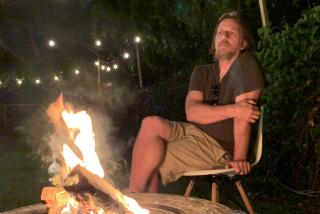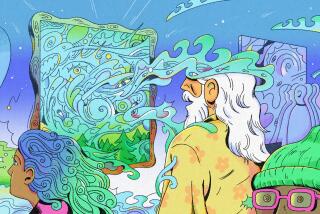Ram Dass, part of the ’60s psychedelic movement, dies at 88
- Share via
In 1963, Richard Alpert ended one life and launched a new one: Ousted from Harvard University’s faculty with co-merrymaker Timothy Leary for giving hallucinogenic drugs to students, he became a point man for the psychedelic movement of the ’60s.
Many drug-fueled highs later, Alpert’s second, and most lasting, transformation occurred. He went on sojourn in India and in 1968 returned as Ram Dass, a name that became synonymous with another of that era’s social and psychological explosions.
As Ram Dass, Alpert spread the word that turning inward was far more powerful than just turning on. A nimble communicator who was articulate, funny and self-effacing, he became a central figure in the movement to make Eastern mysticism understandable to Western minds.
Ram Dass, 88, who died Sunday at his home in Maui, according to a post on his Instagram account, described his metamorphoses in “Be Here Now” (1971), a counterculture classic still in print almost four decades and millions of copies later.
As popular in its time as Dr. Spock’s baby manual, it became the hippie bible, offering a personal parable of enlightenment as well as practical guidance on yoga and meditation decades before such practices became mainstream.
“He was the voice for applied spirituality — his life was the model,” bestselling self-help author Wayne Dyer once said.
Ram Dass in some ways reinvented himself again in 1997 after a debilitating stroke left him partially paralyzed and unable to speak. He learned to depend on others and appreciate the silences that remained after he recovered some of his speech. The trailblazer of the 1960s and ‘70s entered the new millennium with hard-won wisdom about “conscious aging,” which he detailed in the book “Still Here” (2000).
Born April 6, 1931, in Boston, he was the youngest of three sons of George Alpert, a Jewish lawyer who was a founder of Brandeis University and president of the New Haven Railroad. He honed an expertise in psychology through three degrees: a bachelor’s from Tufts University in 1952, a master’s from Wesleyan University in 1954 and a doctorate from Stanford University in 1957. He joined Harvard’s faculty in 1958.
When the ’60s dawned, Alpert was living high. He had appointments to teach in four departments at Harvard — Social Relations, Psychology, the Graduate School of Education, and the Health Service, where he was a therapist — and had research contracts with Yale and Stanford. He lived in an antiques-filled Cambridge apartment, drove a Mercedes-Benz sedan and a Triumph motorcycle, and flew his own Cessna plane.
At the same time, he was “living a lie,” according to journalist Don Lattin, who profiles Alpert and other counterculture figures in “The Harvard Psychedelic Club” (2010). With a male lover in San Francisco and a female lover in Cambridge, Alpert was struggling to keep the strands of his sexual life separate. Teaching at Harvard was beginning to feel like an elaborate game.
Then he met Leary.
A Harvard lecturer in psychology, Leary had encountered a fungus with unusual properties on a 1960 trip to Mexico. The “magic mushrooms” contained psilocybin, a hallucinogenic substance. Once he ate a few of the mushrooms, his life changed dramatically. He founded a psilocybin research project at Harvard and began experiments with a synthetic form of the mushroom’s mind-altering ingredient.
In early 1961, after a semester at UC Berkeley as a visiting professor, Alpert joined Leary’s wild party, which by then included some of the leading bohemian intellectuals of the day, such as Beat poet Allen Ginsberg and Buddhist writer Alan Watts. Leary gave his colleague 10 milligrams of synthetic psilocybin and Alpert went up, up and away.
First, “the rug crawled and the pictures smiled, all of which delighted me,” Alpert recalled in “Be Here Now.” Then he slid deeper into himself, feeling each of his identities — teacher, lover, pilot, son — dissolving. As he shed each role he was filled with escalating sensations of wonder and bliss, akin to a religious awakening
He joined Leary in the research project, which initially examined whether psilocybin could be used as a therapeutic agent: They administered the drug to prisoners, for instance, to find out if it could make criminals less likely to break the law.
But soon they were also giving psilocybin and LSD to students. According to Lattin, one of the people who turned them in to the administration was then-Harvard undergraduate Andrew Weil — the future guru of holistic medicine — who exposed the professors’ misdeeds in the Harvard Crimson and Look magazine. Alpert and Leary’s activities became a national scandal and the two were booted out of Harvard.
The academic exiles became outspoken advocates of LSD, or “acid” as it became known to a legion of youthful users. Alpert said the drug was “less dangerous than a four-year liberal arts college education” and lectured about its potential to groups as varied as the Food and Drug Administration and the Hell’s Angels. In 1967 he and Leary were headliners at the Human Be-In, a massive gathering of hippies in Golden Gate Park where Leary issued his famous call to “turn on, tune in, drop out.”
By 1968, however, the news was full of stories about acid trips that ended badly, in psychotic breakdowns and suicide. The federal government banned LSD later that year.
A burned-out Alpert sought relief in India. There he met a Hindu holy man named Neem Karoli Baba, whom his followers called Maharaji. Alpert immediately had an extraordinary exchange with the spiritual teacher. Without Alpert telling him, Maharaji knew that his Western visitor had spent the previous night thinking about his mother, who had died six months earlier of an enlarged spleen. The holy man knew when she died and what caused her death.
The conversation blew Alpert’s mind. After considering “every super CIA paranoia I’ve ever had,” he began sobbing.
The next day, Maharaji asked for the “medicine” Alpert had brought from the United States. Alpert was stunned: He had not said a word to the mystic about the bottle of LSD he had hidden in his pack. But he had brought the drug to India exactly for this purpose: to find a holy man who could explain the nature of its magic.
He gave Maharaji 900 micrograms, a substantial dose that should have produced a substantial reaction. But the mystic seemed unfazed.
After hours passed with the guru doing nothing more than “twinkle” at Alpert in his usual way, Alpert realized that the guru had no need for pharmaceutical help to reach a higher state of consciousness. Love, Maharaji told him, was a much stronger drug.
Over the next several months, Alpert stayed with the guru to study Hindu philosophy, yoga and meditation. When he left India, he was Ram Dass, Hindi for “servant of God.”
Back in the U.S., people who had known him as the ex-Harvard oracle of LSD flocked to hear what he had to say as the berobed Baba Ram Dass. He gave workshops at Esalen, the New Age retreat in Big Sur, and he lectured around the country. He talked about how the Eastern path to enlightenment differed from “the Western hang-up — the tremendous need to know, along with not knowing that you know.”
Such talk led some to scorn him as a new kind of snake-oil salesman. The National Lampoon dubbed him Baba Rum Raisin. His father called him Rum Dum.
But to many others who, like Alpert, had not found lasting fulfillment in psychedelics, Ram Dass was a sage for a new age.
Part of his appeal was his acknowledgment that he was no saint, that he had “lusts and fears just like real people do.” He joked, for instance, about the time a follower found him in line to see the X-rated movie “Deep Throat.”
During the 1970s and 1980s, critics attacked him for not supporting political and social causes. He responded by launching several nonprofit organizations, including the Seva Foundation, which works to alleviate disease and poverty around the world. He donated most of his speaking fees to charity, particularly his Hanuman Foundation.
There was also the time in the mid-1970s, after Maharaji’s death, when Alpert became a follower of a Brooklyn woman named Joya, who claimed to be an enlightened being. After studying with her for a year, however, Ram Dass renounced her as a charlatan, confessing his mistake in a 1976 article for Yoga Journal called “Egg on My Beard.”
The affair caused him to lose credibility with his followers for a while, but he continued to write books and reach out to new audiences. Two decades after he first burst into public consciousness as a counterculture icon, he found himself addressing large audiences of people who had never gotten high or chanted a mantra.
One night in early 1997 he was at home in bed in Marin County, contemplating an ending for his book about aging. He was imagining what it would be like to be old and infirm when he noticed that his leg seemed to have fallen asleep. He got up to answer the phone but fell to the floor. “I didn’t realize,” he wrote later, “that my leg was no longer working because I’d had a stroke.”
He nearly died from the massive cerebral hemorrhage. It not only took away his ability to walk and talk but shattered his self-image as a vibrant 65-year-old. “I thought I was at the end of a graced life,” he recalled in a 2004 interview with the San Francisco Chronicle.
Therapy helped him learn to talk again, but the words came so haltingly — and often failed him completely — that he considered giving up public speaking. But he eventually resumed a lecture schedule. And he finished the book that became “Still Here.” Some disability advocates cringed at its references to the ennobling aspects of suffering, but other critics appreciated its gentle teachings about growing older.
“The stroke,” Ram Dass wrote, “was unbearable to the Ego, and so it pushed me into the Soul level.... From the Soul’s perspective it’s been a great learning experience. Although I’m more in the spirit now, I’m also more human.”
More to Read
Start your day right
Sign up for Essential California for the L.A. Times biggest news, features and recommendations in your inbox six days a week.
You may occasionally receive promotional content from the Los Angeles Times.








